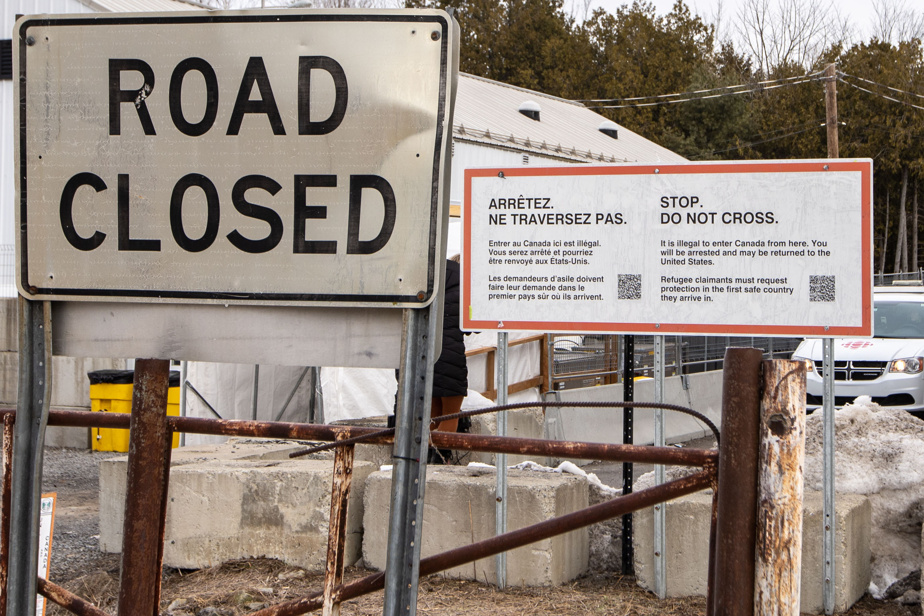(Ottawa) Trump-inspired “invisible wall” for New Democrats, “great news” for Liberals. Gray areas remain surrounding the new terms of the Safe Third Country Agreement, and questions about its application are being raised after a first weekend of Roxham Road closure.
The Trudeau government was pleased to have succeeded in tightening the screw, and to have been able to make the announcement during the visit of President Joe Biden to Canada last Friday. In one camp as in the other, it is seen as a way of promoting orderly migration to the border.
The agreement was signed a year ago, but since Washington had to go through an “operationalization”, its entry into force took months – and if there were a few hours between the announcement and the closing of the checkpoints unofficial, it was to avoid a crush, said a government source in Ottawa.
The Agreement is therefore henceforth applied all along the border of some 8900 kilometers between Canada and the United States. In exchange, 15,000 migrants will be received through regular channels over the next 12 months. Where will they come from? How will we choose them?
Immigration, Refugees and Citizenship Minister Sean Fraser had no answers Monday. “Obviously, I think of Haiti, not just because of the situation there, but also because of the close ties that unite the Haitian people to Canadian communities,” he said at a press briefing in Toronto.

PHOTO ADRIAN WYLD, THE CANADIAN PRESS ARCHIVES
Immigration, Refugees and Citizenship Minister Sean Fraser
He would not say whether the United States had asked more of Canada in return for the 15,000 people who will be admitted here – in 2022 alone, nearly 40,000 migrants took the Roxham Road, and more than two million migrants crossed the border between the United States and Mexico.
“We never wanted to approach it from the angle of the exchange of one person for another. It is difficult for me to imagine that this concept is a reason for starting bilateral negotiations”, argued the minister, after announcing a project on the hiring of refugees and other qualified displaced persons.
Few interceptions at Roxham
For the authorities responsible for applying the Agreement to Roxham Road, the time is of course not yet for in-depth reviews. That of the weekend was, however, communicated to The Press by the Canada Border Services Agency (CBSA).
“According to preliminary data, from March 25 at 12:01 a.m. EDT until midnight on March 26, 16 requests have been processed; 9 asylum seekers were returned to the United States […] and 7 were deemed eligible to pursue their claim for protection in Canada,” wrote CBSA spokesperson Guillaume Bérubé.

PHOTO JOSIE DESMARAIS, THE PRESS
On Roxham Road, on the American side, the day after it was closed
The Royal Canadian Mounted Police declined to comment on the impacts of the revised version of the agreement, in particular the application of the provision that people intercepted within 14 days of crossing the border are then turned back.
“We are deploying our border resources to areas that are most at risk between entry points. It is in the nature of our police work to adapt our interventions and our resources, ”said a spokesperson, Tasha Adams.
On this subject, Prime Minister Justin Trudeau did not offer much more detail.
“The system we had put in place at Roxham was to analyze people so that they could stay. Now, we are not going to have to do the same level of process, ”he argued during a brief scrum with the press before rushing into the House.
“Invisible Wall”
There, during question period, New Democrat Jenny Kwan fell head over heels for the Trudeau government.
“The Liberals secretly brokered a deal to close the entire Canada-US border with an invisible wall. […] Why do liberals take their inspiration from the book of [Donald] Trump? “, she protested.
After her, Bloc Québécois Alexis Brunelle-Duceppe wondered what would happen to the contract without a call for tenders granted for a decade to a businessman close to the Liberal Party, Pierre Guay, near Roxham Road.1.
To her interlocutors, Marie-France Lalonde, Parliamentary Secretary to Minister Fraser, replied that it was a “major victory”, “excellent news”, and that the migration system would now be marked by “compassion” and “benevolence”.
And the Supreme Court?
The bilateral pact was renegotiated while it is before the Supreme Court of Canada. The hearing before the highest court in the country took place last October2and the verdict should thus fall in the coming weeks.
“While we cannot speculate on what the judgment might be, we are developing contingency plans for any potential scenarios,” Immigration Department spokesperson Rémi Larivière said in an email. .
